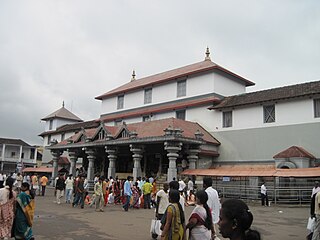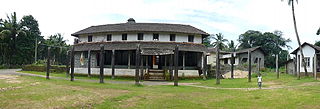
Parashurama, also referred to as Rama Jamadagnya, Rama Bhargava and Virarama, is the sixth avatar among the Dashavatara of the preserver god Vishnu in Hinduism. He is believed to be one of the Chiranjivis (Immortals), who will appear at the end of the Kali Yuga to be the guru of Vishnu's tenth and last incarnation, Kalki.

Pashupati is a Hindu deity and an incarnation of Shiva as the "Lord of the animals". Pashupati is mainly worshipped in Nepal and India. Pashupati is also the national deity of Nepal.

Madhvacharya, also known as Purna Prajna and Ānanda Tīrtha, was an Indian philosopher, theologian and the chief proponent of the Dvaita (dualism) school of Vedanta. Madhva called his philosophy Tattvavāda meaning "arguments from a realist viewpoint".

A matha, also written as math, muth, mutth, mutt, or mut, is a Sanskrit word that means 'institute or college', and it also refers to a monastery in Hinduism. An alternative term for such a monastery is adheenam. The earliest epigraphical evidence for mathas related to Hindu-temples comes from the 7th to 10th century CE.

Dharmasthala is an Indian temple town on the banks of the Nethravathi River in the Belthangady taluk of the Dakshina Kannada district in Karnataka, India.

Tigalari, also known as Tulu script, is a Southern Brahmic script which was used to write Tulu, Kannada, and Sanskrit languages. It was primarily used for writing Vedic texts in Sanskrit. It evolved from the Grantha script. It is referred to as Tigalari lipi in Kannada-speaking regions and Tulu speakers call it as Tulu lipi. It bears high similarity and relationship to its sister script Malayalam, which also evolved from the Grantha script.
The Shivalli Brahmins are a Hindu Brahmin community in Karnataka. They are divided into two groups, the first of who follow the Dvaita philosophy founded by the Vaishnava saint Madhvacharya of Udupi are called Shivalli Madhva Brahmins, and the second of who follow the Advaita philosophy of Adi Shankara are known as Shivalli Smartha Brahmins. Majority of Shivalli Brahmins are Madhvas and only a few of them are Smarthas.

Sri Jayatirtha, also known asTeekacharya, was a Hindu philosopher, dialectician, polemicist and the sixth pontiff of Madhvacharya Peetha from. He is considered to be one of the important seers in the history of Dvaita school of thought on account of his sound elucidations of the works of Madhvacharya. He structured the philosophical aspects of Dvaita and through his polemical works, elevating it to an equal footing with the contemporary schools of thought. Along with Madhva and Vyasatirtha, he is venerated as one of the three great spiritual sages, or munitraya of Dvaita. Jayatirtha is considered an incarnation of Indra with avesha of Adi Sesha in the Madhva Parampara.

Kadri Manjunatha Temple is a historic temple in Mangalore in the state of Karnataka, India. The incharge and priests in the temple are Shivalli Madhva Brahmins.

Sri Vadiraja Tirtha was a Dvaita philosopher, poet, traveller and mystic. He authored many works, often critical, on Madhva theology and metaphysics. Additionally, he composed numerous poems and as the pontiff of Sodhe Mutt, renovated the temple complex at Udupi and established the Paryaya system of worship. He also enriched the Kannada literature of the time by translating Madhvacharya's works to Kannada, giving impetus and contributing to the Haridasa movement. He has influenced both Carnatic and Hindustani music through his compositions. His compositions are mainly in Kannada and Sanskrit. His mudra is 'Hayavadana'. His works are characterised by their poetic flourishes, wit and humour.

Pajaka is a village in Udupi Taluk and district of Karnataka state in India. Pajaka is the place where Dvaita philosopher Sri Madhvacharya was born. The place is near Kunjarugiri Durga temple.

Bannanje Govindacharya was an Indian philosopher and Sanskrit scholar versed in Veda Bhashya, Upanishad Bhashya, Mahabharata, Puranas and Ramayana. He wrote Bhashyas (commentaries) on Veda Suktas, Upanishads, Shata Rudriya, Brahma Sutra Bhashya, Gita Bhashya and was an orator. He was awarded the Padma Shri by the Government of India in 2009.

Udupi Shri Krishna Temple is a well-known historic Hindu temple dedicated to Krishna and Dvaita Matha located in the city of Udupi in Karnataka, India. The Matha area resembles a living Aashram, a holy place for daily devotion and living. Surrounding the Shri Krishna Temple are several temples namely the Udupi Anantheshwara Temple which is over a thousand years old.
The Tulu Ashta Mathas of Udupi are a group of eight mathas or Hindu monasteries established by Madhvacharya, the preceptor of the Dvaita school of Hindu thought with his direct disciples to be the first Swami, head of the matha.

Sad Vaishnavism, , is a denomination within the Vaishnavism—Bhagavata tradition of Hinduism. Sad Vaishnavism was founded by thirteenth century philosopher-saint Madhvacharya, who developed the Tattvavada (dvaita) Vedanta sub-school of Hindu philosophy.

The Uttaradi Math, is one of the main monasteries (matha) founded by Madhvacharya with Padmanabha Tirtha as its head to preserve and propagate Dvaita Vedanta (Tattvavada) outside Tulunadu region. Uttaradi Math is one of the three primary Dvaita monasteries or Mathatraya that descended from Madhvacharya in the lineage of Padmanabha Tirtha through Jayatirtha. After Jayatirtha and Vidyadhiraja Tirtha, Uttaradi Math continued in the lineage of Kavindra Tirtha and later in the lineage of Vidyanidhi Tirtha. The Moola Rama and Moola Sita idols worshipped in the Uttaradi Matha have a long history and are revered among adherents.

The Panchagrama Brahmins are a Brahmin community that follow the Smartha Sampradaya. They belong to the Indian state of Karnataka, and reside primarily in the districts of Udupi, Shimoga and Chikmaglur, Bengaluru and other cities.

Hinduism is the most followed Religion in India and nearly 84% of the total population of Karnataka follows Hinduism, as per 2011 Census of India. Several great empires and dynasties have ruled over Karnataka and many of them have contributed richly to the growth of Hinduism, its temple culture and social development. These developments have reinforced the "Householder tradition", which is of disciplined domesticity, though the saints who propagated Hinduism in the state and in the country were themselves ascetics. The Bhakti movement, of Hindu origin, is devoted to the worship of Shiva and Vishnu; it had a telling impact on the sociocultural ethos of Karnataka from the 12th century onwards.

Madhva Brahmins, are Hindu Brahmin communities in India, who follow Sadh Vaishnavism and Dvaita philosophy propounded by Madhvacharya. They are found mostly in the Indian states of Karnataka, Maharashtra, Goa, Tamil Nadu, Kerala, Telangana and Andhra Pradesh.
Madhva Vaishnavas or Sadh Vaishnavas or Madhvas are Hindu communities in India, who follow Sadh Vaishnavism and Dvaita philosophy propounded by Madhvacharya. They are found mostly in the Indian states of Karnataka, Maharashtra, Goa, Tamil Nadu, Kerala, Telangana and Andhra Pradesh.















